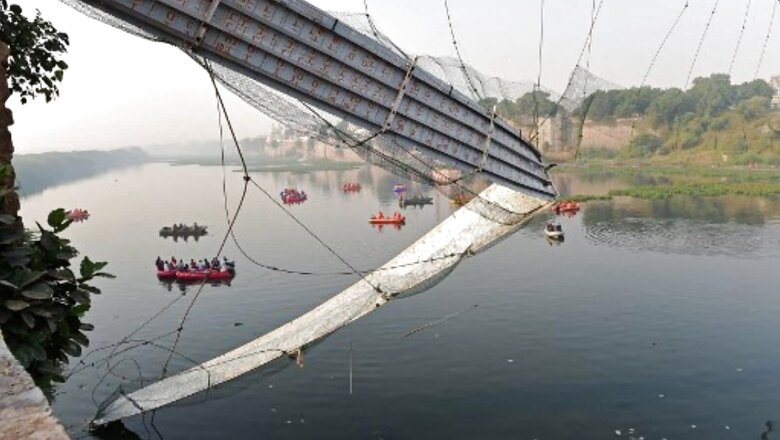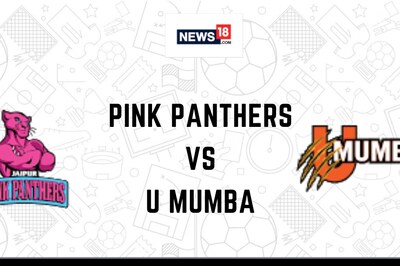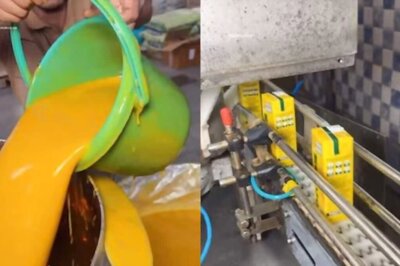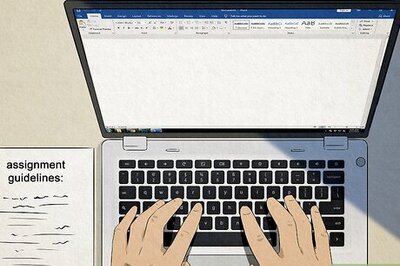
views
A LEAF FROM THE PAST
I begin telling three tales:
One, July 13, 2009. Venue: Outside the chamber of Metro man E Sreedharan, managing director Delhi Metro Rail Corporation. Time: 0845 hours. I am waiting with bated breath. Chief Minister Sheila Dikshit has called DMRC MD office looking for Sreedharan. So has S Jaipal Reddy, Union Urban Minister. Reason: Sreedharan has resigned as Managing Director of DMRC owning the moral responsibility of the previous day accident at Jamrudpur in posh South Delhi, when a launching girder came crashing down on the elevated Central Secretariat-Badarpur line, killing six workers and injuring 20 people.
Sreedharan enters office at sharp nine and gets busy returning the long list of VIP calls. After he finishes calls, I slip inside his chamber and sit silently in a corner (I had the blessings of the free entry in his room particularly at crisis time). I just wanted to be there. Sreedharan is firm, he will not take his resignation back. It takes full might of the state government, central government the ruling party and even opposition to convince Sreedharan to stay back. Even then, his next in command is booted out and the contractor Gammons India after a swift enquiry is banned.
The question I pose: “Why India has to have only one Sreedharan?”
With creaking urban infrastructure and collapsing bridges (old, new and under construction), potholed roads, burning mounds of solid waste dumps, cities without drinking water and sewage, metropolises drowning after two hours of rains, city pollution choking humans, termite of corruption eating cities live (it is an endless list), why is there no one to take the responsibility and fix the malaise? Why does the buck not stop with the top? When an accident occurs, why are the weakest in the link hounded?
Two, July 2011. I am vicariously elated. Near Wenzhou, a city in the south-eastern China, a High-Speed Train (300 kmph plus) has crashed, killing 40 and seriously injuring 200. In the crash, I dream of the victory of my ‘CHINDIA Rail’ comparison that I have been making in international rail Conferences outside India, since 2006 where, I boasted that eventually the Elephant will dance, resulting in the grand triumph of India’s “Babuji Dhire Chalna” saga.
I am crowing, China’s ambitious program of 15,000-km greenfield high speed rail network is derailed and jinxed.
How shortsighted, how wrong was I?
The Chinese government made swift investigation, arrived at the conclusion that the crash was owing to the faulty design and sloppy management and hauled up top 54 officials found guilty.
Cut to circa 2022.
By the time of 2021 end, China’s high-speed rail network has sprawled to 40,000 km, reaching out to 93% of cities with over 500,000 population. By 2030, China will have 75,000-km high speed rail network, much larger than the total route length of railways in India. And it is exporting its high-speed rail technology globally.
There has been no such accident since 2011.
Why can’t there be such zero tolerance for incidents, accidents and fatalities across all sectors of infrastructure both in urban and rural India, along with swift investigation and applied learning to eliminate fatalities and serious injuries?
I say loudly, it is the intent and not the difference in the type of governance in the two countries that has transformed China. If you disagree, I posit, consider the following: Sweden, a democratic country like India, decided that enough was enough and in 1997, the Swedish Parliament enacted a ‘Road Traffic Safety Act’ that put Vision Zero into the Swedish law with the simple goal — no one would die or be seriously injured in a road accident. The initiative led to more than halving of deaths on Swedish roads.
The question I ask is why we the people cannot create such simple goals vision for Mother India? Till when will the ‘Chalta Hai’ attitude, infamous Jugaad mentality, rampant callousness and collusion keep killing hapless innocent Indians – pedestrians and cyclists crushed on city roads or simply going down the gutter in an open manhole in Mumbai and Bengaluru or destitute keep getting washed away in Chennai floods or thousands dying of killer pollution at Delhi annually and worse near the toxic burning solid waste mound Dhapa in Kolkata, 50,000 rag pickers and waste collectors having ultralow life expectancy of 45 years against India’s 69.2 years.
When will my India wake up?
Three, it is time to inject a personal note. For the past six months on News18 platform, I have written nonstop Infra Vaani columns, dissecting the myriad woes of city infrastructure in Indian metropolises, analyzing its root causes and offering ways out of the mess. It began humbly with a 1,000 word piece on Pune, but soon was 2,000-word piece for India’s Silicon Valley Bengaluru, 2,500-word piece when I tackled the maximum city Mumbai and a mammoth 4,000 words by the time I hit the infra woes of the capital punishment, Delhi, Detroit of India, Chennai, the City of Joy turned the city of sorrow, Kolkata and Hyderabad, the city of Nawabs.
Lakhs of readers have read Infra Vaani and thousands have reposted on Linkedin and tweeted and retweeted. But in the past six months, no state government or city government has taken any cognizance. Perforce, despite the active encouragement of my editors and readers, even I, a die-hard optimist and a firm believer in the power of the idea of India as a super power and developed country am spending sleepless nights losing hope. I am convinced that even my latest piece on the unfortunate Morbi tragedy published in Moneycontrol will fall on the deaf ears of governance in various states.
So, what do you say — Should I stop writing? Probably, yes. But my three-pound turbulent mind eggs me on not to give up but to become more focused and smarter and keep on writing.
Because I know the power of India is such that someday, someone will notice and start acting on what I write or talk. And this conviction is borne from my past experiences. When I worked as the Project Director cum Team Leader of the Pre-feasibility Study of Dholera Special Investment Region (SIR) in the first decade of this century, little did I know there would be a Narendra Damodar Modi, who would own the dream, I wrote on a paper napkin over dinner in a Gandhinagar hotel — a New Gujarat within Gujarat, a new Singapore, four times the size of Singapore. I also did not know when I wrote in the preamble of the new Industrial Policy of Delhi State that there will be either Delhi or the industry in Delhi, there would be a Delhi bureaucrat who would convince Sheila Dikshit and her cabinet to adopt that policy. And, truth beckons, when E Sreedharan, then CMD Konkan Railway Corporation (KRCL), put on my tiny shoulders in 1990s (after Harshad Mehta Securities Scam), the impossible task to bring money (beg, borrow, but no steal) to construct Konkan Railway, even I did not believe in Sreedharan’s lofty dream, but the greatness of steely Sreedharan rubbed on me and I turned his ‘Hanuman’ with the result that when I left Konkan Railway in May 1997 for the greener pasture of private sector (which soon turned the brown manure), the entire money to complete Konkan Railway was largely in place and Konkan Railway was a “dream that came true” .
So, the pathological day dreamer in me, continues to push the envelope with the audacious hope that soon the decaying, creaky and collapsing urban infrastructure of India will be past and passe. And I have reason for this optimism. In 1998 when E Sreedharan, a Member of the Delhi State Government Committee to select the Managing Director of Delhi Metro Rail Corporation, was forced by the destiny to take the mantle of DMRC MD, who could have visualized that in 2022, India would have an 850-km operational metro rail network in 20 cities, another 900 km in construction and more than 1,000 km in advanced state of planning in three dozen cities, actualizing the dream of Prime Minster Modi that 50 cities and towns of India will have metro rail.
There is power in the idea of India.
TIME IS RUNNING OUT
According to the United Nations Department of Economic and Social Affairs, Population Division World Population Prospects 2022: Summary of Results, India will surpass China as the world’s most populous country during 2023. Also, India, with barely 2% of global landmass at 1.4 billion population in 2022, is the home to 18% of the global population — 16% in 2011 and likely 20% in 2031.
And the consensus estimates are that India’s urban population in 2030 will be 600 million. Also, as per United Nations, India’s urban population is estimated to grow to 675 million in 2035. Unsurprisingly, sooner India will have more than one hundred million plus cities, with seven megacities of the world, and Delhi dethroning Tokyo as the most populous city globally by 2028.
This being the case, time is running out for India for creating necessary sustainable infrastructure for its urban population, and although it will need trillions of dollar investment in the infrastructure, money is the least of the problems.
URBAN INDIA – THE ENGINE OF GROWTH
Urban India today accounts for 63% of the country’s Gross Domestic Project (GDP) which will grow to 75% of the GDP by 2031 and go beyond 80% of GDP by 2050. Quite clearly, if India has to find its place in the galaxy of developed nations by 2047, Indian cities have to become livable first and thriving engines of growth in perpetuity.
URBAN INFRASTRUCTURE CHAOS- A SORDID SAGA
I have enumerated travails of Indian urban infrastructure chaos in more than dozen articles at News18 platform in the past six months in as many as humungous more than one hundred thousand words. Interested serious readers are advised to Google ‘Akhileshwar Sahay News18’ to dwell deeper. For the uninitiated, for sake of brevity, I recapitulate the principal urban infra woes as under:
One, the growing poverty and destitution in absolute numbers despite appreciable poverty reduction in percentage terms is proving bane to India.
Two, disrupted habitat where the country is already home to the world’s largest homeless population who have nothing much to live and aspire for, puts our head in collective shame. India is the sole country in the world which criminalises destitution and puts destitute behind bars for 13 years without warrant and in the name of sham summary trial under the draconian provisions of Bombay Beggary Act, 1959.
Three, increasing ghettoization and unlivable urban slums devoid of minimum basic civic amenities swarming cities and towns are biggest urban tragedy while the erroneous dominant persisting statutory and policy paradigm being – ‘slum mukt urban India’, acronym for slum eradication/ clearance.
Four, grossly inadequate and fast worsening, pitiable state of the solid waste management even in metropolitan cities, notwithstanding Prime Minister’s Swachh 1.0 and 2.0 Mission and despite the Supreme Court mandated Solid Waste Management Rules, 2016.
Five, fast growing water poverty with many cities staring at Day Zero (with contamination of surface water and fast depleting ground water) with resultant misery of cities and towns parching without adequate drinking water and sanitation facility.
Six, when urban India is not dying without water, the poor, destitute and rich alike are getting submerged and dying in flash floods. While the worsening urban floods of Chennai are of gigantic proportion, mere two to three hours of heavy rains clog all cities and towns. The increasing global temperature and worsening climate change have just made it more uncertain and far worse.
Six, insufficient city roads with atrocious road conditions (potholes define roads of urban India) with foot soldiers (pedestrians and cyclists) having nowhere to go means- people are losing life and limbs at the altar of urban roads.
Seven, despite low per capita vehicle population, India has already surrendered to massive motorization, while Delhi has 1.3 crore vehicles, Mumbai roads have 2,000 vehicles per kilometer and Kolkata has no roads to ply automobile. Motorization chaos is increasingly becoming the defining problem of tier 2/3 cities and mufassil towns
Eight, pollution rules the roost. According to the report ‘Air Quality and Health in Cities’, released by US-based Health Effects Institute in April 2022, India’s capital city New Delhi is the most polluted city in the entire world, with West Bengal’s Kolkata bagging the second spot. And this is the beginning, more than 60 Indian cities have the vaunted place in world top hundred most polluted cities of the world according to many reports
Nine, there is a comprehensive urban transport chaos and total urban transport gridlock with the mobility of the poorest and mobility of urban freight compromised the most. And this is the story not only of metropolitan cities, but even small towns.
Ten, towering infernos (urban fire) and creaky and collapsing bridges, roads and poorly constructed buildings is annually killing and maiming scores of Indians. And it is not just that old and creaky are falling from the sky, but even new constructions and under construction infrastructure is caving in with alarming frequency. Morbi tragedy is a symptom of a larger disease known as urban India.
Eleven, callousness and complicity apart, poor construction materials and poor construction methodology and no accountability of officials or contractors are the bigger issues. There is neither capacity (technical or institutional) nor accountability of ULBs and other infrastructure creators, regulations are lax and poorly implemented, laws are weak and enforcement atrocious. Who will forget Uphaar cinema fire tragedy in the heart of the national capital on June 13, 1997, in which 59 innocent lives were lost, but where justice was denied simply because it came inordinately late. In most other cases, culprits go freely unpunished and perpetrate the crime again and again. Even advocates, doctors and chartered accountants have their governing bodies and code of conduct, but barrier of entry for engineers and contractors is conspicuous by absence and the lax law and long hands of the culprit does the rest.
And the complex calculus of the termite of corruption will kill India before the nation becomes the developed country.
POSTSCRIPT
Wake up India, Jago Re Bharat.
Despite the ‘Permanent Revolution’ of Prime Minister Modi, his dream of making India developed country by the end of Amrit Kaal, when India celebrates its 100 years of independence is under serious threat. And the time to prevent it from being stillborn begins now and to make that happen, every Indian has to become the gatekeeper of the idea of India.
If India has to find its place in the galaxy of nations, it is reboot time for urban India first. And the malaise runs so deep that no quick fix and band aid solution will work, it is time for a holistic overhaul.
Urgent lifesaving surgery is the sole nostrum which has some hope from saving the India dream from dying.
Akhileshwar Sahay is a Multidisciplinary Thought Leader with Action Bias ad Impact Consultant. Of his own volition, he is a pathological day dreamer, who believes in the India story. Sahay works as President Advisory Services of Indian consulting major BARSYL. Views are personal and do not reflect the views of this publication or the company where he works for.
Read all the Latest Opinions here




















Comments
0 comment